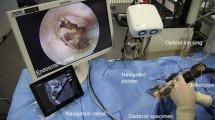Abstract
Three-dimensional navigation systems are routinely used in endoscopic skull base surgery, neurosurgery, maxillo-facial and endoscopic sinus surgery. Their precision can, however, change in the course of one experiment. We have compared five different 3D navigation systems and discuss here possible reasons for the limits of system precision. A plexiglass cube on which test points were marked served as a test-model. Two well-trained system users measured the distances between the test points in each of the five systems. The results were compared with reference data provided by the NUMEREX™ device at the Technical University of Vienna. The accuracy data shown by all these 3D navigation systems ranged from 0.0 mm to 6.67 mm. The accuracy data of a system calculated in advance did not always correspond with the system precision on the screen. The system precision in the center of the cube was higher than on its surface, which made us conclude that the angle between the tracker system and the pointing device touching the test point may be critical for system precision. Applying an automatic registration step did not result in greater system precision. Slice thickness and the angle of the pointing device seem to be responsible for system precision.
Similar content being viewed by others
Author information
Authors and Affiliations
Additional information
Received: 3 July 2000 / Accepted: 1 November 2000
Rights and permissions
About this article
Cite this article
Cartellieri, M., Kremser, J. & Vorbeck, F. Comparison of different 3D navigation systems by a clinical “user”. European Archives of Oto-Rhino-Laryngology 258, 38–41 (2001). https://doi.org/10.1007/s004050000302
Issue Date:
DOI: https://doi.org/10.1007/s004050000302




